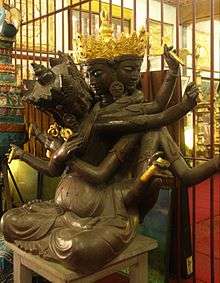Yab-Yum

| Part of a series on |
| Vajrayana Buddhism |
|---|
 |
|
Traditions Historical traditions:
New branches:
|
|
History |
|
Pursuit |
|
Practices |
|
Festivals |
|
Ordination and transmission |
| Vajrayana Buddhism portal |
Yab-yum (Tibetan literally, "father-mother") is a common symbol in the Buddhist art of India, Bhutan, Nepal, and Tibet. It represents the primordial union of wisdom and compassion, depicted as a male deity in sexual union with his female consort. The male figure represents compassion and skillful means, while the female partner represents insight.
Origins
The symbolism is associated with Anuttarayoga tantra and, while there are various interpretations of the symbolism in twilight language, the male figure is usually linked to compassion (karuṇā) and skillful means (upāya-kauśalya), while the female partner to "insight" (prajñā).[1]
Iconography
Yab-yum is generally understood to represent the primordial (or mystical) union of wisdom and compassion.[2] In Buddhism the masculine form is active, representing the compassion and skillful means (upaya [3]) that have to be developed in order to reach enlightenment. The feminine form is passive and represents wisdom (prajna), which is also necessary to enlightenment. United, the figures symbolize the union necessary to overcome the veils of Maya, the false duality of object and subject.
These figures are frequently worked in the shape of statues [4] or reliefs, or are painted on thangkas. Yab-yum may also be represented through the aniconic signification of yantra and mandala.
Tibetan Buddhism
In Tibetan Buddhism, the same ideas are to be found concerning the bell and the dorje, which, like the yab-yum, symbolize the dualism that must be exceeded. The sacred Tantric practice leads to rapid development of mind by using the experience of bliss, non-duality, and ecstasy while in communion with one's consort.
Hinduism
In Hinduism the yab-yum has a slightly different meaning. There, the embraced posture represents the divine strength of creation. The Hindu concept is the one of a passive masculine deity embracing his spouse called shakti, which represents his activity or power. The iconic yab-yum of Chakrasamvara-Vajravarahi is directly influenced from the Hinduist depiction of Kali and Bhairava in union.
Sadhana
The symbolism of union and sexual polarity is a central teaching in Tantric Buddhism, especially in Tibet. The union is realised by the practitioner as a mystical experience within one's own body.[5]
As a tantric practice, Yab-yum is akin to the Karmamudrā or "actionseal". This is the tantric yoga involving a physical partner. However, the aim of the practice is to control one's winds. This sadhana is part of the completion stage.
Gallery
-
.jpg)
Heruka with prajna Vajravarahi. Discovered in Nepal, statue on display at Prince of Wales museum. (1544 AD).
-

Padmasambhava in Yab-Yum.
See also
Footnotes
- ↑ Keown, Damien. (2003). A Dictionary of Buddhism, p. 338. Oxford University Press. ISBN 0-19-860560-9.
- ↑ The Marriage of Wisdom and Method By Marco Pallis
- ↑ upaya Encyclopædia Britannica
- ↑ Paramasukha-Chakrasamvara and Vajravarahi
- ↑ Herrmann-Pfandt, Adelheid. "Yab Yum Iconography and the Role of Women in Tibetan Tantric Buddhism." The Tibet Journal. Vol. XXII, No. 1. Spring 1997, pp. 12-34.
